The next-gen MacBook Pro with Retina Display Review
by Anand Lal Shimpi on June 23, 2012 4:14 AM EST- Posted in
- Mac
- Apple
- MacBook Pro
- Laptops
- Notebooks
Ports & Expansion
Port layout has been greatly simplified on the next-gen MacBook Pro. Along the left side there’s now a MagSafe 2 connector, two Thunderbolt ports, one USB 3.0 and one 1/8” jack for mic/headphones. The right side has the other USB 3.0 port, a full sized HDMI port and an SD card reader.
MagSafe 2 is a thinner version of Apple’s MagSafe connector, and it’s used on both the Retina MacBook Pro and the 2012 MacBook Airs. The rMBP still ships with the same 85W power adapter as before, but now with an integrated MagSafe 2 connector. In order to deal with the change in connector, Apple offers a $10 converter that allows you to plug MagSafe 1 power supplies into MagSafe 2 systems. All new Thunderbolt Displays shipping from here on out will include the MagSafe 2 converter.
The absence of an integrated Gigabit Ethernet port will surely bother some, but Apple offers a Thunderbolt to GigE adapter for $30 to accommodate. Since Thunderbolt effectively offers an external PCIe interface, there’s no performance loss if you go this route vs. the old integrated GigE connector. I was able to sustain nearly 930Mbps between the rMBP with the Thunderbolt GigE adapter and last year’s MBP:
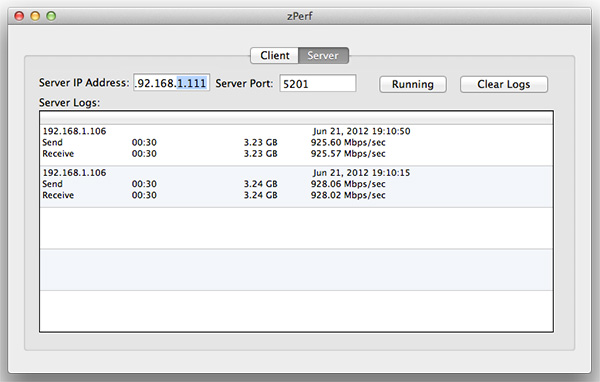
At a price of $30 Apple is most certainly using Intel’s Port Ridge Thunderbolt controller, a cost effective single-channel TB controller without any support for DisplayPort passthrough.
USB 3.0 is provided courtesy of Intel’s 7-series chipset. Apple supports the USB Attached SCSI protocol which should allow for even better performance than what I’m showing below (with all of my focus on Thunderbolt I actually don't have a 6Gbps UASP enabled USB 3.0 dock in house):
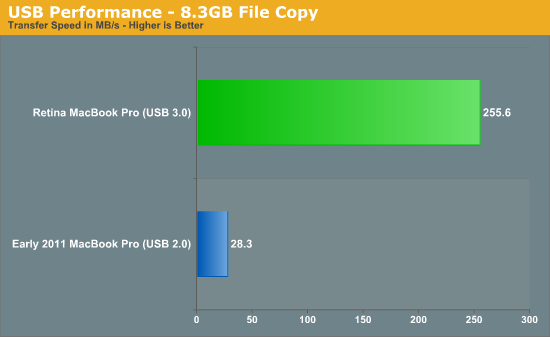


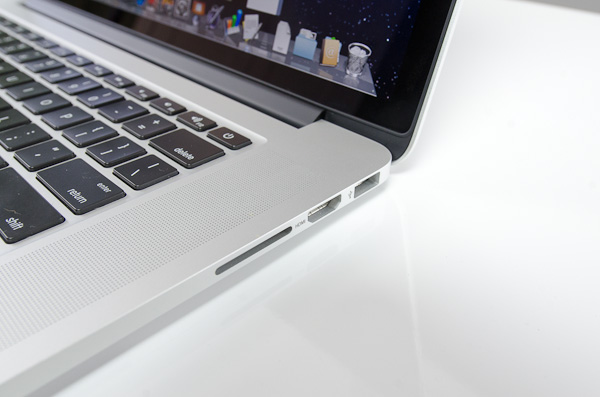
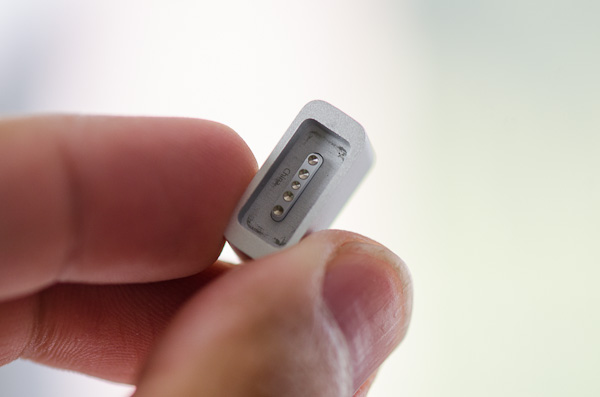
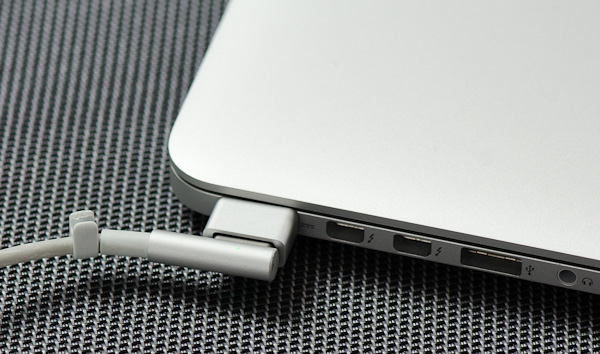








471 Comments
View All Comments
rs2 - Monday, June 25, 2012 - link
...the $2200 one that doesn't include an optical drive and has nowhere to put one. It's not like I want my $2200 device to be usable as an impromptu blu-ray player or anything like that. No, I have money to burn buying extra appliances that do things that my pricey laptop should be able to do, but can't.That's what I might say if I had a hole in my head, at any rate.
rs2 - Monday, June 25, 2012 - link
Also, statements like this seem at least somewhat questionable:"The absence of an integrated Gigabit Ethernet port will surely bother some, but Apple offers a Thunderbolt to GigE adapter for $30 to accommodate."
So Apple leaves out a feature that many people would expect as standard in a high-end laptop, but it's okay because they also happen to sell an optional, paid add-on accessory that provides gigabit ethernet connectivity? Same goes for their $10 power-supply adapter cable.
How about calling them out for trying to nickel-and-dime people to death?
Fx1 - Monday, June 25, 2012 - link
God people like you make me sick.95% of people never used the ethernet port. i would rather than 25% shaved off the profile and weight. 10$ isn't much if your one of the sad people to have to use an ethernet.
Spending £2000 on a laptop I'm not going to care about £7 on a adapter
Spunjji - Tuesday, June 26, 2012 - link
Chill. Either you're sick a lot or you're being hyperbolic...Putting Ethernet in won't increase width by 25%. There are many, many ways to do it and there are thinner laptops out there that support it, even if using hideous dongles. Furthermore there are a wealth of legitimate reasons for wanting it.
Basically what I'm saying is, STFU noob.
Spunjji - Tuesday, June 26, 2012 - link
Yay for paying for baseline features! That adaptor should come as standard with a laptop this expensive. Their penny-pinching with respect to their actual margins is infuriating.ramb0 - Monday, June 25, 2012 - link
Thanks Anand, nice description of what's going on here with the Retina scaling.How is it possible that a 600x600 (for example) image looks better on the rMBP than it does on a standard MBP, and occupies the same amount of screen realestate?
I understand the Backing Scale of 2.0 draws the pixes 4 times more, so therefore appears the same size as on a 1440 screen, but i don't understand how this works for a .jpg image for example.
If it is just using pixel doubling, wouldn't the quality between the "retina" display and normal display be exactly the same, because it is just multiplying each pixel by 4. So essentially you end up with 4 pixels that are the same as each one.
Also, on a separate note, it would be great if you could set the text & UI elements in scale mode of 1680 x 1050 or 1920 x 1200, but keep the "work space" elements as native 2880x1800 (Backing scale 1.0).
wfolta - Monday, June 25, 2012 - link
As I understand it, the image will not look better. Images on disk, say, can look better (because you see pixels you couldn't have seen before). Some websites, like Apple's, will feed you higher-density images than if you were browsing with another machine, and obviously those will look better.Lepton87 - Monday, June 25, 2012 - link
Somehow I doubt that you would be so lenient towards any other company, but if there are glitches in apple hardware it's your fault by your own admission or someone else is at fault. Way to stay neutral and impartial.
Evil_Sheep - Monday, June 25, 2012 - link
Wow, a real bronze medal from Anand! Fewer of these are handed out than Olympic bronze medals in odd-numbered years. And all Apple had to do was innovate and ship a completely revolutionary computing paradigm in displays which, in stark contrast to its PC competition, works virtually flawlessly from day one right down to reprogramming minute graphics routines and on a topic Anandtech has been loudly harping on for years.But never let it be said that Anandtech is too generous with its awards.
Freakie - Monday, June 25, 2012 - link
Hey Anand, or any other employee of the website, aren't there a few parts of this review that very specifically break your traditional object reviews of products and hardware? I mean, it's fine to be excited about something, as Anand is obviously about this laptop, but I think he is so excited that the website's integrity is a little bit compromised. I realize that anyone from the website reading this will recognize that I don't have any right to speak about the integrity of an article written by Anand himself on his own website, but I feel like it should be said anyways, in hopes of keeping your minds clear and objective.It's just things like praising the fact that they got rid of an extra piece of glass on the screen, and how much praise Anand gave for this admittedly stupid thing to point out. As Anand said, this is a matte screen, not a glossy screen, so there being an extra piece of glass in the front would be completely ridiculous, right? The only mention of other matte screens is that those who have used a matte screen in the past are used to not having a protective piece of glass or plastic in between them and when the real LCD starts. Other than that, there isn't anything special about it not having that extra piece of glass. Yet it just baffles me how much Anand goes on about how it has magically been engineered away somehow.
Sorry if I sound pretentiously opinionated. I just really felt that the integrity and methodical reviews that so many people come to Anandtech.com for feels very lacking in this review >_<